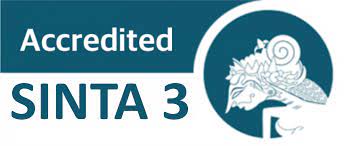STUDENTS’ PERCEPTION ON THE USE OF ESTAFET WRITING GAME AND PICTURE BASED-CREATIVE WRITING TO NURTURE LOVE OF WRITING
Abstract
To create a quality education, mainly on EFL instruction, the EFL teachers need to be empowered with improving their teaching quality. The students, on the other hand, should also be actively engaged during the instructional activities. Due to the fact that love of “writing” as one of the language skills is not yet established among the EFL university students, the effort of finding out an innovative way of helping them to establish love of creative writing is a must. One of the ways is collaborative writing through Estafet Writing Game and Picture-Based-Creative Writing strategies. Thus, this article aims at describing the students’ voices on the use of those strategies to establish love of creative writing. The study conducted through a reflective questionnaire survey to 165 EFL university students reveals that most of the respondents prefer Estafet Writing Game to Picture-Based Creative Writing in terms of its effectiveness to build their creativity and spontaneity of writing skills. To sum up, these strategies are pedagogically meaningful to improve the EFL students’ creative writing, because they can collaborate with their peers and promote their cooperative communication. Therefore, it is useful to establish love of writing and to stimulate their ideas for writing.
Keywords
Full Text:
PDFReferences
Al Seyabi, F., & Tuzlukova, V. (2014). Writing problems and strategies: An investigative study in the Omani school and university context. Asian Journal of Social Sciences & Humanities, 3(4), 37-48.
Altınmakas, D., & Bayyurt, Y. (2018). An exploratory study on factors influencing undergraduate students’ academic writing practices in Turkey. Journal of English for Academic Purposes.
Astuti, E. W. (2016). The Use Of Cooperative Learning To Improve Students’writing Skill On Procedure Text.(A Classroom Action Research At the Eight Grade of SMP Muhammadiyah 6 Plupuh, Sragen in the 2015/2016 Academic Year). Karya Ilmiah Mahasiswa Progdi Pendidikan Bahasa Inggris FKIP, 2(1).
Bikowski, D., & Vithanage, R. (2016). Effects of web-based collaborative writing on individual L2 writing development.
Dao, P., & McDonough, K. (2017). The effect of task role on Vietnamese EFL learners' collaboration in mixed proficiency dyads. System, 65, 15-24.
Gutiérrez, K. G. C., Puello, M. N., & Galvis, L. A. P. (2015). Using pictures series technique to enhance narrative writing among ninth grade students at Institución Educativa Simón Araujo. English Language Teaching, 8(5), 45.
Han, Y., & Hyland, F. (2015). Exploring learner engagement with written corrective feedback in a Chinese tertiary EFL classroom. Journal of Second Language Writing, 30, 31-44.
Hassaskhah, J., & Mozaffari, H. (2015). The impact of group formation method (student-selected vs. teacher-assigned) on group dynamics and group outcome in EFL creative writing.Journal of Language Teaching and Research, 6(1), 147-156.
Hammad, E. A. (2016). Palestinian University students’ problems with EFL essay writing in an instructional setting. InTeaching EFL Writing in the 21st Century Arab World (pp. 99-124). Palgrave Macmillan, London.
Kiriakos, C. M., & Tienari, J. (2018). Academic writing as love.Management Learning, 1350507617753560.
McDonough, K., De Vleeschauwer, J., & Crawford, W. (2018). Comparing the quality of collaborative writing, collaborative prewriting, and individual texts in a Thai EFL context. System,74, 109-120.
Nazim, M. (2018). Writing As A Skill: Problems Identified And Pedagogical Remedies. Advances in Social Sciences Research Journal, 5(7).
Ningsih, W., & Razak, N. K. (2017). The Effectiveness of Cooperative Integrated Reading and Composition Model in the Teaching and Learning Narrative Essay Writing. Journal of Indonesian Language Education and Literary, 2(2, Dec.), 134-137
Setyowati, L., & Sukmawan, S. (2016). EFL Indonesian Students' Attitude toward Writing in English.
Phuket, P. R. N., & Othman, N. B. (2015). Understanding EFL Students' Errors in Writing. Journal of Education and Practice,6(32), 99-106.
Thuy, N. H. H. (2016). Teaching efl writing in Vietnam: Problems and solutions-a discussion from the outlook of applied linguistics. VNU Journal of Science: Foreign Studies,25(1).
DOI: https://doi.org/10.18860/abj.v4i1.6305
Refbacks
- There are currently no refbacks.
Copyright (c) 2019 Abjadia

This work is licensed under a Creative Commons Attribution-NonCommercial 4.0 International License.
...............................................................................................................................................................
Mailing Address:
Ruang Jurnal Abjadia, Fakultas Ilmu Tarbiyah dan Keguruan (FITK)
Universitas Islam Negeri (UIN) Maulana Malik Ibrahim Malang
Jalan Gajayana 50 Malang 65144, Jawa Timur, Indonesia
Phone/Faximile: (+62341) 552398, Phonsel: +6281333666063
Website: http://ejournal.uin-malang.ac.id/index.php/abjadia
Email: abjadia@uin-malang.com
Abjadia: International Journal of Education. This work is licensed under a Creative Commons Attribution-ShareAlike 4.0 International License.
...............................................................................................................................................................
Indexed by:






